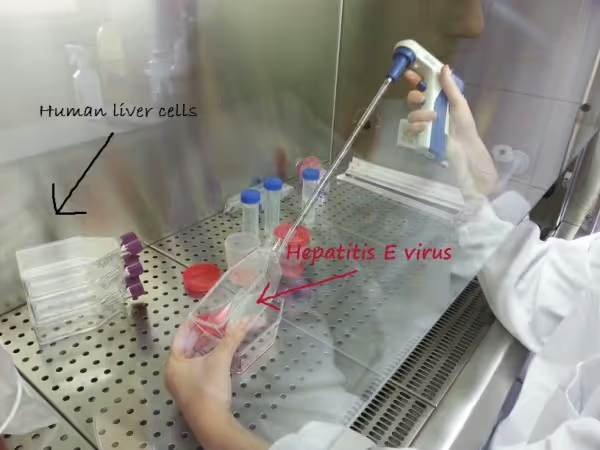Hepatitis E Virus grows and multiplies in vitro!

Before starting disinfection experiments in water we needed to have lots of Hepatitis E Virus viable particles to expose them to different treatments (chlorine, UV, flocculation…), in order to understand how effective they are towards this important pathogen causing recurrent epidemics in central Africa and Asia. Last month (Dec 2013) a new outbreak has been reported by WHO in Tanzania.
Although the virus replication mechanisms are little known, in our laboratory we have set up an in vitro system to replicate the Hepatitis E Virus (HEV) in order to have large amounts of this pathogen for further experiments.
The experimental method consists basically of infecting with HEV (adapted strain) a hepatoma cell culture (human liver cells). The virus affects the liver when ingested, so we’ve reproduced the conditions as a real infection to let the virus multiply freely in human liver cells. In particular, we grow cells in sterile flasks and once they cover the whole surface we inoculate little amounts of HEV (provided by NIH). Then, we add growing medium to provide with the necessary nutrients to the infected cells and incubate at 34.5C for several weeks. Each week we replace the medium containing viral particles by fresh medium. With our system, we got high doses for disinfection assays, for which we‘ll need about a billion particles (1.000.000.000.000 viruses).

As soon as we have the amounts needed, we will show you how we test HEV for water disinfection!
Have a good New Year!
Any further questions or comments please send an email to:[email protected]
Stay updated
Sign up for our newsletter to receive regular updates on resources, news, and insights like this. Don’t miss out on important information that can help you stay informed and engaged.
Related articles
.png)


Explore Elrha
Learn more about our mission, the organisations we support, and the resources we provide to drive research and innovation in humanitarian response.